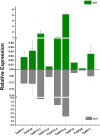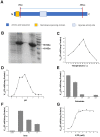Genome-wide identification, characterization and expression pattern analysis of APYRASE family members in response to abiotic and biotic stresses in wheat
- PMID: 31565565
- PMCID: PMC6744936
- DOI: 10.7717/peerj.7622
Genome-wide identification, characterization and expression pattern analysis of APYRASE family members in response to abiotic and biotic stresses in wheat
Abstract
APYRASEs, which directly regulate intra- and extra-cellular ATP homeostasis, play a pivotal role in the regulation of various stress adaptations in mammals, bacteria and plants. In the present study, we identified and characterized wheat APYRASE family members at the genomic level in wheat. The results identified a total of nine APY homologs with conserved ACR domains. The sequence alignments, phylogenetic relations and conserved motifs of wheat APYs were bioinformatically analyzed. Although they share highly conserved secondary and tertiary structures, the wheat APYs could be mainly categorized into three groups, according to phylogenetic and structural analysis. Additionally, these APYs exhibited similar expression patterns in the root and shoot, among which TaAPY3-1, TaAPY3-3 and TaAPY3-4 had the highest expression levels. The time-course expression patterns of the eight APYs in response to biotic and abiotic stress in the wheat seedlings were also investigated. TaAPY3-2, TaAPY3-3, TaAPY3-4 and TaAPY6 exhibited strong sensitivity to all kinds of stresses in the leaves. Some APYs showed specific expression responses, such as TaAPY6 to heavy metal stress, and TaAPY7 to heat and salt stress. These results suggest that the stress-inducible APYs could have potential roles in the regulation of environmental stress adaptations. Moreover, the catalytic activity of TaAPY3-1 was further analyzed in the in vitro system. The results showed that TaAPY3-1 protein exhibited high catalytic activity in the degradation of ATP and ADP, but with low activity in degradation of TTP and GTP. It also has an extensive range of temperature adaptability, but preferred relatively acidic pH conditions. In this study, the genome-wide identification and characterization of APYs in wheat were suggested to be useful for further genetic modifications in the generation of high-stress-tolerant wheat cultivars.
Keywords: APYRASE; Abiotic and biotic stress; Enzymatic activity; Expression pattern; Wheat.
©2019 Liu et al.
Conflict of interest statement
The authors declare there are no competing interests.
Figures








References
LinkOut - more resources
Full Text Sources

